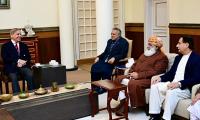According to the ‘Global Gender Gap Report 2021’ published by the World Economic Forum (WEF), Pakistan ranked 153rd out of 156 countries on the gender parity index. Pakistan ranked seventh among eight countries in South Asia, only better than Afghanistan. Pakistan’s gender gap has even widened by 0.7 percentage points in 2021 compared to 2020.
The WEF also uses four sub-indexes to measure the ranking of 156 economies on various dimensions of gender parity. These dimensions include economic participation and opportunity, educational attainment, political empowerment, and health and survival. Pakistan ranked 153rd in health and survival, 152nd in economic participation and opportunity, 144th in educational attainment, and 98th in political empowerment indices.
The same report shows that Pakistan failed to improve its score on gender parity in the last sixteen years (the gender parity score was 0.553 in 2006 and 0.556 in 2021). These statistics show that overall progress in reducing the gender gap is stagnant in Pakistan. The report indicates that Pakistan needs 136 years to close the gender gap, with the existing performance rate.
On the other hand, regional countries, including Bangladesh and India, have shown remarkable improvement to reduce the gender gap. The gender parity score has increased from 0.627 in 2006 to 0.719 in 2021 in Bangladesh (ranked 65th in the world out of 156 countries). Similarly, India and Sri Lanka have a better ranking on gender parity compared to Pakistan.
After careful evaluation of the WEF index and encapsulating statistics that directly illustrate the gender gap in Pakistan compared to other economies globally, it can be deduced unequivocally that Pakistan currently has one of the worst gender gaps in the world. It must improve its standards towards gender parity to ensure a higher ranking in the future.
Before providing policy solutions, let us review the interventions introduced by the Pakistan government to reduce the gender gap and enhance women's empowerment. First, Pakistan launched a women-centric national cash transfers program, namely the Benazir Income Support Program (BISP), to financially empower women in 2008. BISP provides cash assistance to over five million beneficiaries across Pakistan.
Various loan schemes were launched to provide loans to women to start small and medium enterprises (SMEs) in the last ten years, such as the Prime Minister Youth Loan Schemes and the Kamyab Jawan Program.
Second, Pakistan introduced various measures to increase school enrollment, especially among girls. Such initiatives include the Waseela-e-Taleem (WeT) program by BISP, free education for girls, and provision of financial assistance by Pakistan Baitul Mal (PBM) and the Higher Education Commission (HEC).
Third, the government introduced health card schemes to available indoor health facilities. Lastly, providing a computerized national identity card (CNIC) to women through BISP offers an opportunity to induce political empowerment.
Why does Pakistan fail to reduce the gender gap despite all these women-centric reforms? Pakistan needs well-targeted and innovative approaches to address the gender gap keeping in view the local realities. We propose various measures to reduce the gender gap in Pakistan:
Economic empowerment: Regularize the informal economy with a specific focus on the country's rural economy where women can easily avail economic opportunities and contribute to the economy. Women-specific livelihood opportunities in more value-added fields such as tourism, hospitality and packaging should be promoted. Encourage entrepreneurship for educated women to participate in e-commerce businesses actively.
A proactive focus is needed in policies and practices to overcome occupational segregation by gender. An effective mid-career reskilling policy, combined with managerial practices, which embed sound and fair hiring and promotion practices will pave the way for a more gender-equal future of work.
Access of women to potential markets is a considerable challenge, especially for women working in the rural market. Finding spaces to sell products by women is very costly for women. The government should develop special zones for women at no cost to provide safe spaces for trading. The government should offer soft loans to women to build micro-entrepreneurs and subsidies inputs to establish new businesses. It is vital to provide modern technologies to women to participate online from their homes in economic activities.
Educational empowerment: Pakistan needs to provide education for every citizen of Pakistan. According to Unicef statistics, an estimated 22.8 million children aged 5-16 are out of school, in which around 60 percent are girls and the remaining 40 percent are boys. To increase the enrollment ratio in primary and secondary education, the government should build new schools and provide training to teachers before recruitment so as to address the drop-out issue.
The provision of schools for girls at a local level is the key to reduce the educational gap. The poor quality of hygiene facilities in public schools is a significant issue that restricts girl school enrollment.
Health empowerment: Improving maternal health is one of Pakistan's critical challenges due to supply constraints, especially in rural areas. A well-targeted awareness campaign operated by Lady Health Workers is needed to increase health facilities among women. Provision of health services at the village level is the only solution to improve maternal health. The government's health card scheme may not solve the problem of maternal health due to mobility issues.
Social empowerment: Social empowerment is the key to achieve economic, educational and health empowerments. Women-led community forums are effective in disseminating information among women on economic facilities provides by the government. Furthermore, these forums are instrumental in overcoming cultural barriers and promoting an inclusive society.
The writer is associate professor at the Pakistan Institute of Development Economics (PIDE).
Email: dr.iqbaln@gmail.com
Many people believe that in future, AI will play an even more significant role in their lives
In April 2024, three Chinese and one Belarusian company were sanctioned for exporting missile-enabling technology to...
Pakistan has second highest neonatal mortality in world; in education sector, country's 26 million kids are out of...
Key actors in global power politics are US, China, Russia, European Union, and emerging powers such as India and Brazil
Maulana Fazl manages to bring together factions that historically stand opposed
NASA says August 2024 set new monthly temperature record, capping Earth’s hottest summer since 1880







